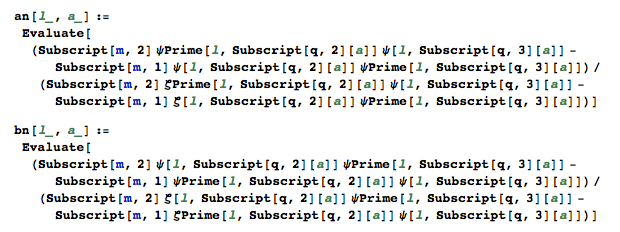Reflections
An important question emerges in the study of scattered light in the interstellar medium (ISM). Why use the Mie solutions to Maxwell’s equations as opposed to the Rayleigh or Debye methods for modeling this scattering? As with many other methodological decisions, the answer lies in the physical parameters and observational requirements of the system that I’m trying to model. Optical observational data of extinction due to dust grains as a function of wavelength is denoted by: $A_\lambda$ and this observed data necessitates that the extinction be inversely proportional to wavelength:
$A_\lambda\propto\lambda{^-1}$
i.e. the wavelength must be approximately the size of the grains in question. Only with that dependency will the the model fit the data. Wavelength dependencies for Rayleigh and Debye scattering do not provide the necessary proportion.
Asymmetry parameter, g
Modeling the Mie solutions to Maxwell’s equations for scattered light by spherical particles has proven tricky. My attempts so far at getting my Mathematica code to work have hit a bit of a snag, with a plot of the asymmetry parameter, g, versus grain size getting stuck on execution of the code (“running”). I am looking into the possibility that I am unable to execute code due to my laptop’s computational strength – a factor that I entirely did not rule into my planning when I laid out my timeline for the project.
Below I’ve laid out my own navigations through Mathematica 9 and the ongoing process of modeling. I made some simplifying (and yet physically relevant) assumptions. The spherical grains will be water ice with an index of refraction of n=1.33. The vacuum will have an index of refraction of n=1. Items [k, 1] and [k, 2] are coefficients for the imaginary portion of the indices of refraction. I have assumed a wavelength within the optical spectrum. [K, 1] – [K, 3] are the wave numbers for the different indices and included are the wavelengths necessary to derive those wave numbers. Lastly I have provided an arbitrary, placeholder grain radius.
I have also defined grain size parameters, necessary for the calculation of the coefficients $a_n$ and $b_n$, shown below.
Part of the complexity and my uncertainty in my code comes in trying to define a complex conjugate function used in the derivation of the Ricati-Bessel and Bessel functions. Below I’ve included the complex conjugate function that I’ve been utilizing.
Helpfully, Mathematica has Bessel functions built in, what I’ve attempted with them is listed below. Note that I am using density as a means of utilizing the Ricati-Bessel functions (wave functions) on a spherical grain. Depending on an interstellar grains properties, i.e. if it’s dielectric and thus has a real index of refraction or it has a complex index of refraction (impure water ice grain), the Bessel or Ricati-Bessel function will change.
Lastly, here’s my code for the coefficients, $a_n$ and $b_n$. $\alpha$ and $\beta$ have been replaced with q, but those values are still the size parameters.
On a side note, this snag has altered my perspective on the nature of computational modeling. I better appreciate the power and growing accessibility to supercomputing.
Resources
- Introduction to Electrodynamics, 4th ed. by David J. Griffiths
- Physics of the Galaxy and Interstellar Matter by H. Scheffler and H. Elsässer
- Interstellar Grains by N.C. Wickramasinghe
- Physical Processes in the Interstellar Medium by Lyman Spitzer, Jr.
- The scattering of light, and other electromagnetic radiation by Milton Kerker
- Mathematica 9 Help Documentation Center (the most valuable resource!)
Mathematica notebook: https://drive.google.com/file/d/0B_r-c0PTUHZldHVNREtrWHlzZXc/edit?usp=sharing






You need to make your Mathematica file publicly available. Also, some visualizations/figures would be helpful.